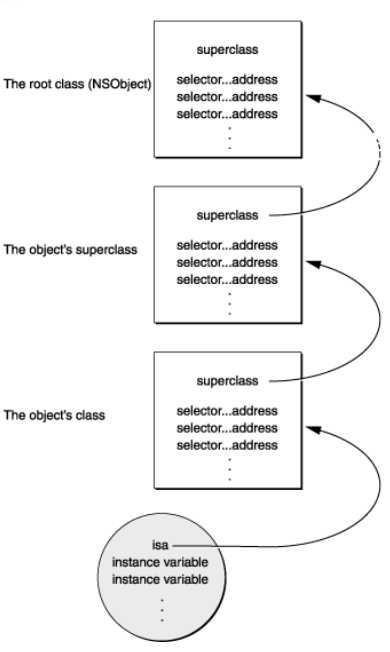typedef struct objc_class *Class;
typedef struct objc_object { Class isa; } *id; typedef struct objc_selector *SEL;
typedef id (*IMP)(id, SEL, ...);
Class 的含义
Class 被定义为一个指向 objc_class 的结构体指针,这个结构体表示每一个类的类结构。而 objc_class 在 objc/objc_class.h 中定义如下:
struct objc_class { struct objc_class super_class; /*父类*/ const char *name; /*类名字*/ long version; /*版本信息*/ long info; /*类信息*/ long instance_size; /*实例大小*/ struct objc_ivar_list *ivars; /*实例参数链表*/ struct objc_method_list **methodLists; /*方法链表*/ struct objc_cache *cache; /*方法缓存*/ struct objc_protocol_list *protocols; /*协议链表*/ };

如图一所示,圆形所代表的实例对象的第一个实例变量为 isa,它指向该类的类结构 The object’s class。 而该类结构有一个指向其父类类结构的指针 superclass, 以及自身消息名称(selector)/实现地址(address) 的方法链表。
注意这里所说的方法链表里面存储的是 Method 类型的。图一中 selector 就是指 Method 的
SEL, address 就是指 Method 的 IMP。 Method 在头文件 objc_class.h 中定义如下:
typedef struct objc_method *Method; typedef struct objc_ method { SEL method_name;//表示该方法的名称
char *method_types;//该方法参数的类型
IMP method_imp; //指向该方法的具体实现的函数指针
};
SEL 的含义:
在前面我们看到方法选标 SEL 的定义为:
typedef struct objc_selector *SEL;
它是一个指向 objc_selector 指针,表示方法的名字/签名。
-(NSInteger)maxIn:(NSInteger)a theOther:(NSInteger)b { return (a > b) ? a : b; } NSLog(@"SEL=%s", @selector(maxIn:theOther:)); 输出:SEL=maxIn:theOther:
IMP 的含义:
在前面我们也看到 IMP 的定义为:
typedef id (*IMP)(id, SEL, ...);
根据前面 id 的定义,我们知道 id 是一个指向 objc_object 结构体的指针,该结构体只有一个成员 isa,所 以任何继承自 NSObject 的类对象都可以用 id 来指代,因为 NSObject 的第一个成员实例就是 isa。
IMP 是一个函数指针,这个被指向的函数包含一个接收消息的对象id(self 指针), 调用方法的选标 SEL (方法名),以及不定个数的方法参数,并返回一个 id。
NSObject 类中的 methodForSelector:方法就是这样一个获取指向方法实现 IMP 的指针, methodForSelector:返回的指针和赋值的变量类型必须完全一致,包括方法的参数类型和返回值类型。
下面的例子展示了怎么使用指针来调用 setFilled:的方法实现:
void (*setter)(id, SEL, BOOL); int i; setter = (void(*)(id, SEL, BOOL))[target methodForSelector:@selector(setFilled:)]; for (i = 0; i < 1000; i++) setter(targetList[i], @selector(setFilled:), YES);
原文:http://www.cnblogs.com/H7N9/p/4892300.html